
Diabetes Protein Puzzle
What's in the Story?
You take another bite of the apple. It's crisp, juicy, and sweet…delicious. Most of us like eating, but why is eating important? The food you eat is broken down in your stomach and intestines and digested into molecules your body uses to work and grow. Some of these molecules are sugars called glucose. Glucose is an important source of energy that lets the cells in your body keep working.
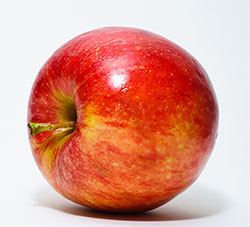
Glucose travels through your veins to get to all the organs, like cars on a highway. For your cells to change glucose into usable energy, glucose has to enter cells through special pathways called glucose transporters. Think of these transporters as highway off-ramps.
If glucose cannot enter cells and gets stuck in the bloodstream highway, bad things can happen. Regular buildup of too much blood sugar can cause the disease diabetes. To keep our bloodstream highways free of too much sugar, we use insulin. Insulin helps glucose take the off-ramps (to enter cells).
Because insulin is so important to the body, scientists took a closer look at just how insulin is made in the PLOS Biology article, "The IRE1α/XBP1s Pathway Is Essential for the Glucose Response and Protection of β Cells."
Keeping the Protein Factory Running
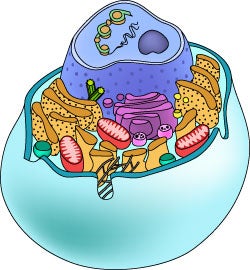
Most of your cells can be thought of as little cities. There are organelles ("tiny organs") that do specific jobs within the cell. Some make new items, others package or ship them, and others might move them out of the cell.
One of the cell factories that make new items is called the endoplasmic reticulum (ER). The ER makes proteins as well as lipids like fat. Each of these molecules has a very specific structure.
Let's look closer at proteins. An important part of the structure of a protein like insulin is the proper folding of the parts of the protein. You can think about this like folding paper for origami. Proteins must be folded into their proper shape to work correctly. This folding happens in the ER.
If the folding doesn't work, a buildup of unfolded proteins in the ER causes ER stress. This can cause the cell to destroy itself. However, just like most factories, the cell has built in tools to detect and fix these issues. One of these tools is a protein named IRE1α. In the presence of unfolded proteins, IRE1α activates itself and turns on another protein called XBP1. Through a series of events, XBP1 will then cause other proteins to come help alleviate the stress caused by the unfolded proteins in the ER.
Think of IRE1α as one of the managers of the factory, who makes sure everything runs smoothly. In case of trouble, IRE1α can call on its employee XBP1 to order other workers to take care of the unfolded proteins.
When the Manager is Missing
So what happens when the cell factory manager (IRE1α) isn’t around? The scientists who wanted to answer that question looked at the changes this caused in the cell.
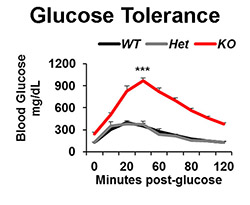
They measured blood glucose before and after a meal in mice and humans that have IRE1α. They also measured the same changes in glucose in mice that were made to not have working IRE1α (called KnockOut, or KO, mice). After healthy mice and humans eat a meal, their blood glucose levels go up. The increased glucose causes insulin to be secreted to allow glucose to go from the blood to other cells.
In knockout mice, however, blood glucose stayed higher in the blood than in the healthy, "wild-type mice" after they ate a meal. Blood glucose not decreasing over time after feeding is indicative of diabetes. The scientists found that mice that lacked IRE1α showed signs of diabetes compared to control mice that still had IRE1α.
Making Insulin
Because glucose and insulin affect one another, the researchers took a closer look at how insulin is made. You can think of making insulin as kind of the same as making an omelet. First you need to have eggs and then you need to scramble them, before you can cook the eggs to make the omelet.
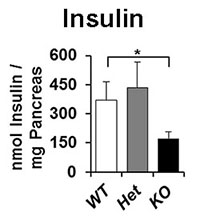
To make insulin, first you need preproinsulin. That is then turned into proinsulin in the ER of the cell. Proinsulin can then be turned into insulin. If you wanted to know how many omelets you could make, you'd need to look at the number of eggs you have. In the same way, to know how much insulin can be made by a cell, you could look at how much preproinsulin or the proinsulin is in the cell.
The researchers looked at how much preproinsulin and proinsulin was in the pancreas in KO mice and wild type mice. They found that the KO mice had a much lower level of proinsulin. In other experiments, they saw that cells in KO mice had a lot of preproinsulin but no proinsulin or insulin.
These findings mean that without the IRE1α protein, the pancreas does not produce much insulin. Without insulin, blood glucose builds up in the KO mice and may cause diabetes.
Stressing the System
The researchers also wondered what a buildup of preproinsulin in the ER might do to cells. They thought that a buildup of this protein might cause a type of cell damage. This particular damage is called oxidative stress.
Oxidative stress has to do with molecules that contain oxygen and that easily react with other molecules. Antioxidants are molecules that can make these oxygen molecules less reactive. The researchers decided to feed the mice antioxidants to see the effects on one type of molecule that causes a lot of oxidative stress: nitrotyrosine.
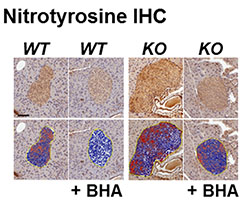
When both wild type and KO mice were fed the antioxidant food, they had much lower levels of nitrotyrosine in their pancreases than similar mice that ate regular food. This shows that food with anti-oxidants can reduce oxidative stress in the beta cells of both WT and KO mice.
Remember that KO mice had much higher glucose levels than WT mice after feeding. But wild type and even KO mice that fed on the diet high in antioxidants had low blood glucose after eating. In fact, their blood glucose was even lower than the healthy wild type mice that ate regular food. This suggests that eating foods with anti-oxidants may be good for those with diabetes.
What Might This Do for Diabetes?
Because the antioxidant food had a positive effect on diabetic mice, the researchers hope it may be able to help people in the same way. Next, they are taking their research a step further. They are trying to learn if these special foods can reduce blood glucose in general. If they can, it could help some people avoid developing diabetes.
Additional images via Wikimedia Commons. Pancreas image via Mikael Häggström. Sugar crystals thumbnail by Sanjay Acharya.
Bibliographic details:
- Article: Diabetes Protein Puzzle
- Author(s): Randal J. Kaufman, Philip Li, Justin Hassler
- Publisher: Arizona State University School of Life Sciences Ask A Biologist
- Site name: ASU - Ask A Biologist
- Date published:
- Date accessed:
- Link: https://askabiologist.asu.edu/plosable/diabetes-protein-puzzle
APA Style
Randal J. Kaufman, Philip Li, Justin Hassler. (). Diabetes Protein Puzzle. ASU - Ask A Biologist. Retrieved from https://askabiologist.asu.edu/plosable/diabetes-protein-puzzle
Chicago Manual of Style
Randal J. Kaufman, Philip Li, Justin Hassler. "Diabetes Protein Puzzle". ASU - Ask A Biologist. . https://askabiologist.asu.edu/plosable/diabetes-protein-puzzle
Randal J. Kaufman, Philip Li, Justin Hassler. "Diabetes Protein Puzzle". ASU - Ask A Biologist. . ASU - Ask A Biologist, Web. https://askabiologist.asu.edu/plosable/diabetes-protein-puzzle
MLA 2017 Style

Be Part of
Ask A Biologist
By volunteering, or simply sending us feedback on the site. Scientists, teachers, writers, illustrators, and translators are all important to the program. If you are interested in helping with the website we have a Volunteers page to get the process started.
